In the EU, 23.9% of people aged 16 years or over reported some or severe long-standing limitations in their usual activities due to health problems (disability) in 2024, according to Eurostat, with 17.2% reporting some limitation and 6.7% reporting a severe limitation.
Across the EU countries, the share of people who reported a disability in 2024 ranged from 12.7% in Bulgaria, 14.2% in Malta and 14.5% in Italy to 41.2% in Latvia. Looking in more detail, Latvia recorded the highest share of people reporting a severe limitation (11.1%) as well as the highest share of people reporting some limitation (30.1%).
Males less likely to report a disability
In 2024, males were less likely than females to report a disability. This pattern was repeated in all of the EU countries, with the widest gender gaps recorded in Portugal, the Netherlands and Finland (6.8 to 9.3%).
On the other hand, Cyprus, Ireland and Slovenia had the smallest differences between the sexes, as the share of females reporting a disability was at most 2% above the corresponding share for males.
A further analysis shows that this gender gap was present in the EU in 2024 regardless of the severity of the activity limitation. The share of people reporting a disability with severe limitation was 1.2 points higher among females than among males, while the gap was wider for people with some limitation, at 3.4 points.
The gender gap for severe limitation – with higher shares for females – peaked among the EU countries at 1.9% in Greece and France. Ireland had the narrowest gap, 0.1% difference.
The gender gap for some limitation – again with higher shares for females – peaked at 7.6% in Portugal, followed by the Netherlands and Finland (both 5.8%), while the narrowest gap was in Cyprus, where the share for females was 0.3% higher than the share for males.
Older people more likely to report a disability
Self-reported disability has a distinct age pattern, as people in higher age groups are more likely than people in lower age groups to report some or severe limitations. In 2024, the share of people aged 16 to 24 years who reported (some or severe) disability was 7.1% within the EU. The highest share was recorded among people aged 85 years or over, at 72.3%.
The gap was narrowest for 5 of the 6 youngest age groups (covering people aged 16 to 44 years and 55 to 74 years), with shares 1.5–2.3 points higher for females. It was somewhat wider for the age group covering people aged 45 to 54 years, with the share 3.7 points higher for women.
However, when focusing just on people reporting severe disability, the gender gap in the EU in 2024 was relatively narrow, at 1.2 points among people aged 16 years or over.
People with higher income levels less likely to report a disability
In the EU, close to a third (33%) of people aged 16 years or over of the 20% of people with the lowest income reported a disability in 2024, compared to just 15.1% for the 20% of people with the highest income).
According to Eurostat, in 2024, almost all EU countries showed a similar pattern to that observed for the EU, with the exception of Slovakia, where a higher share of people reported a disability within the middle range of income than within the lowest income.
People with tertiary education less likely to report a disability
In the EU, 32.9% of people aged 16 years or over having completed, at most, lower secondary education reported a disability in 2024.
This can be compared with 23.7% among people having completed upper secondary or post-secondary non-tertiary education and 15.7% among people with a tertiary level of educational attainment.
This gap between educational attainment levels was apparent in nearly all EU countries, with the same general pattern as that observed for the EU as a whole, with only exception among the EU countries being Latvia, where a lower share of people reported a disability among people having completed, at most, lower secondary education than among people having completed upper secondary or post-secondary non-tertiary education.
The widest gap in the share of people reporting a disability between people with the highest and the lowest educational attainment levels was observed in Croatia (37.7 points), followed by Cyprus (35.4 points). The narrowest gap among the EU countries was observed in Sweden (12.5 points).
(Source: CNA)









